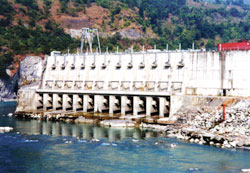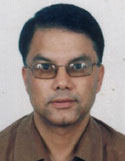
MAROONED: A family in Holiya VDC in Banke sits out floods that swept the region on 25 August. Tens of thousands are still waiting for relief.
(RAMESWOR BOHARA)
. There is a 20 percent shortfall in power supply on the north Indian grid this summer
. Parts of New Delhi are suffering six-hour power cuts daily
. Nepal sits on anywhere between 45,000-80,000 MW
There is demand, and there is supply, yet Nepal and India can't agree on sharing power and water for mutual benefit.
Joint river projects are a political hot potato in Nepal because of the perception that India took advantage of past schemes. After 1990, there were efforts to start multipurpose projects like Mahakali and Tanakpur, but those are also stalled.
Now, the private sectors in India and Nepal are trying to see if they can succeed where their governments failed. The Independent Power Producers' Association of Nepal (IPPAN) and the Power Trading Corporation (PTC) of India are holding a 'Power Summit' in Kathmandu this week to fast-track joint hydropower projects.
"We need to treat hydropower as a commodity, not just for export but also for our own growing domestic use," says IPPAN's Sandip Shah, "This conference is a good start. We have to delink power from geopolitics and governments must leave the business of business to business."
In order to stay away from politics, investors on both sides are showing pragmatism by talking just electricity and keeping multipurpose projects out of the equation for now.
"We want to discuss energy and leave it to market forces," says the PTC's chairman Tantra Thakur, "there are complementarities we could use for mutual benefit."
Over 30 top Indian investors, bankers and technocrats are attending the two-day conference. Nepal's proximity to load centres in northern India is seen as ideal. Nepal also generates surplus hydropower during the monsoon when demand in India is highest, and India's thermal plants generate a surplus when Nepal has a winter shortage.
An immediate priority is to connect the two grids so more power can be traded. Nepal has asked India for 100MW to meet this year's winter shortfall in exchange for which Nepal will provide spill energy to India next monsoon. But this won't be possible until cross-border transmission lines are in place.
"We will consider positively Nepal's request for supply of electricity on commercial terms during the coming winter," Indian ambassador Shiv Shanker Mukherjee told the conference, "although India has its own power shortage."
In the medium-term, the conference will look into political risk for investors in Nepal, which has been a stumbling block for the only other export project currently planned, the 750MW West Seti. Although one Indian investor felt "political risk in Nepal is not as serious as it is made out to be", it is a concern for offshore investors.
 Nepal is not Bhutan
Nepal is not Bhutan
It's counter-productive to push for the Bhutan model here
Analysis by Ratna Sansar Shrestha
Then it comes to Nepal's water resources, talk of emulating Bhutan tops the agenda for so-called hydro-experts, policymakers, activists and a growing number of ordinary Nepalis. Dissenters are branded ultra-nationalist, and many say that we should stop complaining about the country being 'sold' every time a treaty is signed.
The claim is made that, thanks to the Druk model, Bhutan's per capita income is now at $1,300 (Wikipedia, March). The standard response is that if a country expels a quarter of its population, as Bhutan has done with its citizens of Nepali origin, its per capita income could easily show a 33 percent rise.
The real story is somewhere in between. Bhutan did expel over 100,000 citizens. But it is also reaping benefit from the Chukha project (336MW) and is already developing Tala (1020MW). There is limited domestic demand for the power generated, given that Bhutan now has a population of just about half-a-million, as well as a limited transmission/ distribution network. Exporting electricity to India is the only financially viable alternative.
Bhutan earns substantial profit from this export due to the financing model it uses. Sixty percent of the investment for any hydro project is provided as a grant, and the rest is a term loan. Technically, the project's total cost is slashed by 60 percent and therefore the cost of generation also goes down by roughly half.
For example, Chilime electricity costs Rs 2.77/kWh to generate. Under Bhutan's financing mechanism, its cost per kWh would drop to approximately Rs 1.40. At that price, we could still make a substantial profit even if we export to India at Bhutan's price, Rs 3.20/kWh (recently increased from Rs 2.40).
Sounds good, but there is a catch. In the 60 years that India has 'assisted' Nepal in developing a number of hydropower projects, we haven't been able offered a financing model similar to that used in Bhutan. On the contrary, every time a treaty is signed between India and Nepal, Nepalis feel cheated.
The latest treaty between Nepal and India on the border Mahakali river illustrates this clearly. The slogan being bandied around at that time was 'half the water and electricity to each country'. Nepal's parliament ratified the treaty in the belief that we were securing 50 percent each of the water and electricity generated from Mahakali for Nepal. But close scrutiny reveals that Nepal actually gets only 3.5 percent of water, 96.5 percent going to India due to a proviso citing 'without prejudice to existing prior consumptive use' in Article 3. Thus it is heavily skewed towards India.
The Bhutan model works because Bhutan is India's protectorate and the latter determines Bhutan's defence and foreign affairs. Nepalis are unlikely to accept such an arrangement, and so chances are that we will not be treated on par with Bhutan. Despite knowing this, Nepali politicians, bureaucrats, businessmen, and bankers keep getting excited about the Bhutan model and clamouring for it. It is common sense that India is uncomfortable about being dependent on an independent Nepal. There could be one way out. If the security of such a project were to be guaranteed by, say, the Indian Army, the comfort level would go up significantly. But there would surely be resistance to this in Nepal.
It looks as if the only solution in sight is for Nepal and India to act in good faith and be mutually magnanimous. And most importantly, stop focusing on any single model of cooperation.
Ratna Sansar Shrestha is a chartered accountant and attorney-at-law.
Good banking from clean energy
Clean Energy Financial Institution opened Thursday as the country's first bank catering to the energy sector in partnership with Winrock International. CEFI will soon be renamed Clean Energy Development Bank. Marty Logan spoke to CEO Manoj Goyal (below, right) and Suman Basnet, director of Winrock's Renewable Energy Project Support Office.
 Nepali Times: Why start this bank now, after six years of development)?
Nepali Times: Why start this bank now, after six years of development)?
Manoj Goyal: The country needs energy badly. Someone has to take the initiative, someone who understands the risks. A bank, with technical know-how is best placed to do that.
Suman Basnet: There has been investment in hydropower and it's been quite significant... however, one problem that banks themselves again and again express is that they don't have the technical competence to do due diligence or evaluate projects. With that expertise we'll be able to analyse a project, decide 'OK, this is a good project' and then put the project itself up as collateral for financing.
How will the partnership work?
SB: Technical assistance from Winrock is centred on increasing CEFI's capacity to be able to do project financing. That means setting up a procedure to evaluate projects, having manuals ready that people can refer to, maybe developing a roster of experts that the bank can tap into, setting up systems software that will help them do due diligence, etc.
Is CEFI's Rs 320 million paid-up capital sufficient?
MG: I'm not satisfied with that amount because this kind of development bank, with such a big agenda, will require more funds. We decided to go ahead with the minimum requirement first and then as we grow in the business we can always add on.  A green bank will understand the long-term investment needed in the energy sector. But are local investors prepared for things like venture financing?
A green bank will understand the long-term investment needed in the energy sector. But are local investors prepared for things like venture financing?
MG: In today's Nepal people are not used to it. But if you look internationally it has worked, so why shouldn't it work for us? It may be risky but there are returns. There has to be a time when you start using these tools... we are preparing the investors' minds for it. We won't be taking too many risks at the beginning; first we want to create one or two success stories.
Do you expect project developers to bring their ideas to you?
SB: We are trying to be proactive, especially in hydropower. We're looking at the different projects in the pipeline (up to 5MW), why they are not progressing, what the barriers are. Quite a few of them, I'm sure, are blocked because of financing... for instance, there is a developer who wants to develop a project but doesn't know anyone who could invest; there are investors who want to put in money but don't know where the projects are. This bank can very well act as a matchmaker.
Will you be limited to hydropower projects?
SB: Hydropower is going to be very important because of its potential here, but we will also finance other renewable energy technologies, especially off-grid rural projects like solar home systems, biogas plants, microhydro plants.
How are other commercial banks reacting to you?
MG: Banks are willing to finance the sector because they see it's a potentially lucrative one. But they're not sure about their exposure; they feel it's a risky venture because they lack the technical expertise. We have Winrock and USAID support, along with investment from the Employees Provident Fund, so we can afford that expertise; at the same time, we speak the banks' language. That combination provides a much higher comfort level for the other banks. We want to send them this message: utilise our services, because no single bank can finance a hydro project.
With so much focus on energy, can you compete for traditional banking business?
MG: Energy will start paying us only after a few years. And we need to sustain ourselves, because investors' expectations are there. For that reason we'll go into traditional banking. But our wish will always be that energy takes over everything else.


